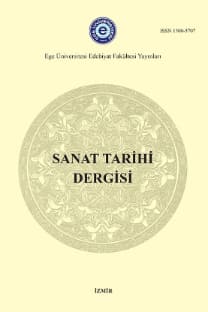Bizans Sanatında “Koimesis” (Meryem’in Uykusu) Tasvirlerinin Kökeni ve İkonografisi
Ortodoks Hıristiyan inancı üzerine temellenen Bizans İmparatorluğu’nda, İsa’nın bedenlenmesine aracı olması nedeniyle büyük hürmet gören ve şefaatçi kabul edilen Meryem’in bu dünyadan göçmesi (Koimesis), önemli Ortodoks bayramları arasında yer alır. Sahnenin ikonografik ögeleri; döşekte yatan Meryem, Meryem’in ruhunu teslim almak üzere göklerden gelmiş olan İsa, İsa’nın ellerinde tuttuğu ve Meryem’in ruhunu simgeleyen bebek (eidolon); Meryem’in ruhunu cennete götürmek üzere gelen melek(ler); Meryem’in döşeğinin etrafını sarmış olan havariler, kilise babaları ve teologlar; evler, yas tutan kadınlar, Meryem’in bedenine zarar vermek üzere döşeğin yanına gelmiş olan Yahudi ve onu engellemek için ellerini kesen melekten oluşur.
Anahtar Kelimeler:
İkonografi, Bizans Sanatı, Meryem, Meryem'in Ölümü, Ortodoks Hıristiyanlık
The Iconography and the Origin of Koimesis (The Dormition of Virgin Mary) in Byzantine Art
In Orthodox Byzantine Empire, Virgin Mary had been venerated with great respect due to her participation of Jesus’ Incarnation and so she had been accepted as an intercessor for the salvation of the mankind. Because of her important place in Orthodox Christian faith, Virgin Mary’s passing away (Koimesis) is one of the most important Orthodox feasts. The iconographic elements of the scene are Mary on her death-bed, Jesus holding Mary’s soul in his arms, Mary’s soul as a baby (eidolon), angels, apostles, church fathers, theologians, houses, mourning women, Jewish man who aims to attack Mary’s body and an angel who cuts the Jewish man’s hands
Keywords:
Iconography, Byzantine Art, Mary, The Dormition, Orthodox Christianity,
___
- DALEY, B. Early Patristic Homilies on the Dormition of Mary, St. Vladimir’s Seminary Press, New York, 1998.
- GAMBERO, L. Mary and The Fathers of The Church, San Francisco, Ignatius Press, 1991. Ξυγγόπουλος, Α. Δελτίον Χριστιανικής Αρχαιολογικής Εταιρείας Περίοδος Δ' Τόμος ΣΤ (1970-1972), 1-12, Η πτερωτή ψυχή της Θεοτόκου. Αθήνα.
- HALDON, J. (çeviren: A. Özdamar) Bizans Tarih Atlası, Kitap Yayınevi, İstanbul, 2006.
- HETHERINGTON, P. (çeviren), The ‘Painter’s Manual’ of Dionysius of Fourna, Oakwood Publications, California, 1996.
- KAZHDAN, A.P. “Andrew of Crete”, The Oxford Dictionary of Byzantium, 1. cilt, Oxford University Press, New York, 1991:92–93.
- PAPADAKİS, A. “Ephesus Council of 431”, The Oxford Dictionary of Byzantium, 1. cilt, Oxford University Press, New York, 1991a:707.
- _____“Council of Chalcedon”, The Oxford Dictionary of Byzantium, 1. cilt, Oxford University Press, New York, 1991b:404.
- SHOEMAKER, S. Ancient Traditions of the Virgin Mary’s Dormition and Assumption, Oxford University Press, New York, 2006.
- TAFT R. ve A. CARR, “Dormition”, The Oxford Dictionary of Byzantium, 1. cilt, Oxford University Press, New York, 199:652-653.
- TALBOT, A.M. “Great Church”, The Oxford Dictionary of Byzantium, 2. cilt, Oxford University Press, New York, 1991:867.
- WALTER, C. “Death in Byzantine Iconography”, Eastern Church Review, VIII, 1976:113–127.
- ISSN: 1300-5707
- Yayın Aralığı: Yılda 2 Sayı
- Başlangıç: 1982
- Yayıncı: Ege Üniversitesi, Edebiyat Fakültesi
Sayıdaki Diğer Makaleler
Osmanlı Devri Edirne Camilerinden Ahşap Va’z Kürsüsü Örnekleri
Ödemiş-Bozdağ Yolu, Paşa Çeşmesi
Amerikan Resminde Müzik ve Dans İmgeleri
Bursa’daki Osmanlı Dönemi Camilerinden İki Va’z Kürsüsü Örneği
Bizans Sanatında “Koimesis” (Meryem’in Uykusu) Tasvirlerinin Kökeni ve İkonografisi
